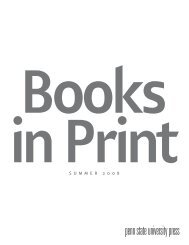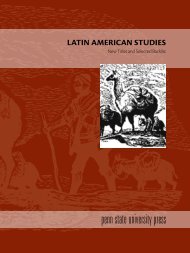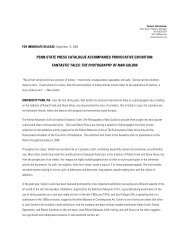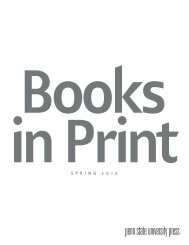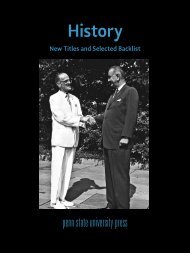Download the Catalog - Pennsylvania State University Press
Download the Catalog - Pennsylvania State University Press
Download the Catalog - Pennsylvania State University Press
Create successful ePaper yourself
Turn your PDF publications into a flip-book with our unique Google optimized e-Paper software.
000<br />
10/20/06 1:30:56 PM<br />
Abraham in Medieval Christian, Islamic,<br />
and Jewish Art<br />
In Michelangelo’s Mirror<br />
Perino del Vaga, Daniele da Volterra, Pellegrino Tibaldi<br />
The Vienna School of Art History<br />
Empire and <strong>the</strong> Politics of Scholarship, 1847–1918<br />
Edited by Colum Hourihane<br />
Morten Steen Hansen<br />
Mat<strong>the</strong>w Rampley<br />
hourihane<br />
ABRAHAM<br />
princeton<br />
vvv<br />
hourihane<br />
TIME IN THE MEDIEVAL WORLD<br />
Abraham, son of Terah<br />
or Azar and husband<br />
of Sarah, is one of <strong>the</strong><br />
pivotal figures of <strong>the</strong> Old<br />
Testament and is generally<br />
seen as <strong>the</strong> founder<br />
of <strong>the</strong> Christian, Jewish,<br />
and Muslim faiths.<br />
He was a rich source of<br />
inspiration in all three<br />
ABRAHAM<br />
faiths for artists of <strong>the</strong><br />
in medieval christian, islamic<br />
and jewish art<br />
medieval period. His life<br />
Edited by colum hourihane<br />
narrative from birth to<br />
death is richly recorded in<br />
a variety of media dating from <strong>the</strong> early Christian period<br />
to <strong>the</strong> end of <strong>the</strong> sixteenth century. As varied as <strong>the</strong>y are<br />
numerous, <strong>the</strong> images in all three faiths show Abraham<br />
as fa<strong>the</strong>r, husband, lover, warrior, politician, refugee, and<br />
traveler but most importantly as <strong>the</strong> symbol par excellence<br />
of steadfastness in faith. Featuring <strong>the</strong> extensive files<br />
from <strong>the</strong> Index of Christian Art, this volume also includes<br />
contributions from The Bezalel Narkiss Index of Jewish Art<br />
by Ariella Amar and Michel Sternthal and a catalogue of<br />
Islamic imagery compiled by Rachel Milstein.<br />
This is <strong>the</strong> first volume from <strong>the</strong> Index of Christian Art to<br />
include not only images from <strong>the</strong> rich Christian holdings<br />
but also from Judaism and Islam. Covering media from<br />
enamels to terra cotta, each entry gives specific information<br />
on <strong>the</strong> object’s current location, source, date, and<br />
artist, where this is known.<br />
Colum Hourihane is Director of <strong>the</strong> Index of Christian Art,<br />
Princeton <strong>University</strong>.<br />
240 pages | 152 color/30 b&w illustrations | 6.5 x 10 | available now<br />
isbn 978-0-9837537-2-8 | paper: $35.00s<br />
http://www.psupress.org/books/titles/978-0-9837537-2-8.html<br />
The Index of Christian Art: Resources Series<br />
Distributed for <strong>the</strong> Index of Christian Art, Princeton <strong>University</strong><br />
Art History<br />
TIME IN THE MEDIEVAL WORLD<br />
occupations of <strong>the</strong> months signs of<br />
<strong>the</strong> zodiac in <strong>the</strong> index of christian art<br />
Edited by colum hourihane<br />
Also of Interest<br />
Time in <strong>the</strong> Medieval World:<br />
Occupations of <strong>the</strong> Months and<br />
Signs of <strong>the</strong> Zodiac in <strong>the</strong> Index<br />
of Christian Art<br />
Edited by Colum Hourihane<br />
isbn 978-0-9768202-3-9 | paper: $35.00s<br />
The Index of Christian Art: Resources<br />
Series | Distributed for <strong>the</strong> Index of<br />
Christian Art, Princeton <strong>University</strong><br />
“Morten Steen Hansen’s<br />
impressively researched<br />
book finally makes sense<br />
of a series of dense, allusive<br />
paintings that have<br />
In Michelangelo’s Mirror<br />
Perino del Vaga, daniele da Volterra, Pellegrino tibaldi<br />
long resisted persuasive<br />
interpretation. But<br />
more than this, <strong>the</strong> book<br />
Morten Steen HanSen<br />
represents a sustained act<br />
of historical criticism: perceiving<br />
<strong>the</strong> ambitions that<br />
run through different projects and shining light on <strong>the</strong>ir<br />
inventiveness, virtuosity, and wit, Hansen makes his three<br />
subjects into newly attractive figures. This is a book that<br />
should change <strong>the</strong> way we teach and write about <strong>the</strong> period.”<br />
<br />
—Michael Cole, Columbia <strong>University</strong><br />
In <strong>the</strong> first decades of <strong>the</strong> sixteenth century, <strong>the</strong> pictorial<br />
arts arrived at an unprecedented level of perfection. That, at<br />
least, was a widespread perception among artists and <strong>the</strong>ir<br />
audiences in central Italy. Imitation, according to <strong>the</strong> artistic<br />
literature of <strong>the</strong> period, was a productive means of continuing<br />
<strong>the</strong> perfections of a predecessor. In Michelangelo’s Mirror<br />
reconsiders <strong>the</strong> question of Italian mannerism, focusing on<br />
<strong>the</strong> idea of imitation in <strong>the</strong> works of such artists as Perino<br />
del Vaga, Daniele da Volterra, and Pellegrino Tibaldi.<br />
Michelangelo was praised as an unsurpassable ideal, and<br />
more than any o<strong>the</strong>r artist he received <strong>the</strong> flattering epi<strong>the</strong>t<br />
divino. As <strong>the</strong> cult around him grew, however, a different<br />
discourse arose. With <strong>the</strong> unveiling of <strong>the</strong> Sistine Last<br />
Judgment in 1541, Michelangelo stood accused of having set<br />
artifice above <strong>the</strong> sacred truth he was meant to serve, effectively<br />
making an idol of his art. Hansen examines <strong>the</strong> work<br />
of three of <strong>the</strong> master’s most talented followers in <strong>the</strong> light<br />
of this critical backlash. He argues that <strong>the</strong>ir choice to imitate<br />
Michelangelo was highly self-conscious and related to<br />
<strong>the</strong> desire to construct <strong>the</strong>ir own artistic identities, ei<strong>the</strong>r<br />
by associating <strong>the</strong>ir work directly with <strong>the</strong> ideal paradigm<br />
(Daniele), through irony and displacement (Perino), or by<br />
incorporating both approaches (Tibaldi).<br />
Morten Steen Hansen is Assistant Professor of Art History<br />
at Stanford <strong>University</strong>.<br />
336 pages | 42 color/109 b&w illustrations | 9 x 10 | July<br />
isbn 978-0-271-05640-1 | cloth: $94.95s<br />
http://www.psupress.org/books/titles/978-0-271-05640-1.html<br />
Art History<br />
Empire and <strong>the</strong> Politics of Scholarship, 1847–1918<br />
“Most art historians know a little about <strong>the</strong><br />
Vienna School of art history, and many of<br />
<strong>the</strong>m have read a couple of essays from that<br />
formative period, especially those by Riegl or<br />
Dvořak. Yet none, I wager, has ever attempted<br />
to envision an entire social and intellectual<br />
biography of this complicated and contradictory<br />
culture that spawned <strong>the</strong> serious beginnings<br />
of <strong>the</strong> history of art. A learned historiographer<br />
to <strong>the</strong> core, Mat<strong>the</strong>w Rampley has<br />
accomplished just that feat. Packed with erudition<br />
(not to mention footnotes!), this hefty<br />
text serves to provide telling episodes from<br />
early German-speaking art history across <strong>the</strong><br />
imperial Habsburg map.”<br />
—Michael Ann Holly,<br />
Sterling and Francine Clark Art Institute<br />
“Drawing on a wealth of sources in many of <strong>the</strong> Empire’s<br />
languages, Rampley shows how <strong>the</strong> School’s most famous<br />
members—Alois Riegl, Max Dvořak, Josef Strzygowski—<br />
fit into a much richer and wider set of debates about<br />
modern art, monument conservation, <strong>the</strong> West’s relationship<br />
to <strong>the</strong> Orient, <strong>the</strong> meaning of <strong>the</strong> Baroque, and <strong>the</strong><br />
relationship between German-speaking Austria and ‘<strong>the</strong><br />
rest.’ This is a crucial book, not only for scholars interested<br />
in <strong>the</strong> historiography of art history, but also for specialists<br />
in Habsburg cultural history.”<br />
—Suzanne Marchand, Louisiana <strong>State</strong> <strong>University</strong><br />
“Mat<strong>the</strong>w Rampley’s book is essential reading for <strong>the</strong> study<br />
of <strong>the</strong> politics of art historical debate, displaying both its<br />
complexity and its internal contradictions. Its particular<br />
strength is its wide-ranging coverage of original source materials<br />
drawing attention to <strong>the</strong> work of hi<strong>the</strong>rto marginalised<br />
art historians, both in Vienna and across <strong>the</strong> Empire.”<br />
<br />
—Richard Woodfield,<br />
<br />
Editor of <strong>the</strong> Journal of Art Historiography<br />
Mat<strong>the</strong>w Rampley’s The Vienna School of Art History is <strong>the</strong><br />
first book in over seventy-five years to study in depth and<br />
in context <strong>the</strong> practices of art history from 1847, <strong>the</strong> year<br />
<strong>the</strong> first teaching position in <strong>the</strong> discipline was created,<br />
to 1918, <strong>the</strong> collapse of Austria-Hungary. It traces <strong>the</strong><br />
emergence of art history as a discipline, <strong>the</strong> establishment<br />
of norms of scholarly inquiry, and <strong>the</strong> involvement of art<br />
historians in wider debates about <strong>the</strong> cultural and political<br />
identity of <strong>the</strong> monarchy.<br />
While Rampley also examines <strong>the</strong> formation of art history<br />
elsewhere in Austria-Hungary, <strong>the</strong> so-called Vienna School<br />
plays <strong>the</strong> central role in <strong>the</strong> study. Located in <strong>the</strong> Habsburg<br />
imperial capital, Vienna art historians frequently became<br />
entangled in debates that were of importance to art historians<br />
elsewhere in <strong>the</strong> Empire, and <strong>the</strong> book pays particular<br />
attention to <strong>the</strong>se areas of overlapping interest. The Vienna<br />
School was well known for its methodological innovations,<br />
and this book analyzes its contributions in this area.<br />
Rampley focuses most fully, however, on <strong>the</strong> larger political<br />
and ideological context of <strong>the</strong> practice of art history—particularly<br />
<strong>the</strong> way in which art-historical debates served as<br />
proxies for wider arguments over <strong>the</strong> political, social, and<br />
cultural life of <strong>the</strong> Habsburg Empire.<br />
Mat<strong>the</strong>w Rampley is Professor and Chair of Art History at<br />
<strong>the</strong> <strong>University</strong> of Birmingham.<br />
336 pages | 18 illustrations | 7 x 10 | January<br />
isbn 978-0-271-06158-0 | cloth: $89.95s<br />
http://www.psupress.org/books/titles/978-0-271-06158-0.html<br />
2-3-9<br />
illustrations from The Pierpont Morgan Library, New<br />
York, Ms. m.440, Psalter-Hours, Brabantine or Mosan,<br />
1261. Front cover, from left to right : Aquarius, Pisces, Aries,<br />
Taurus, Gemini, Cancer, Leo, Virgo, Libra, Scorpio, Sagittarius,<br />
and Capricorn. Back cover, from left to right : January<br />
through December.<br />
princeton<br />
Art History<br />
8 | penn state university press www.psupress.org | 9



